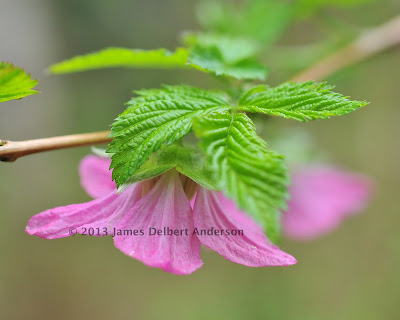Boeing Creek Park will always have a special significance for me. It was where, first on childhood walks with my family and, later, solitary adolescent wanderings, I learned to love hiking. It is also a lot more diverse than most forested parks in the Seattle area. Indeed, although most of the park consists of second-growth, the park is sprinkled with old Douglas firs, most of them along and within the ravine created by Boeing Creek. Why were these giants spared? Park signs suggest that it may have been due to the steep, unstable slopes on which they were and are situated.
Simply hiking through the park - particularly over time - reveals this to be entirely plausible. The ravine's slopes reveal themselves to be very steep in some places. More than that, though, this breathtakingly dynamic park's annual changes demonstrate why it would be impractical or even dangerous to operate logging equipment in some places. The soils are sandy and prone to collapse. Every spring, the trail greets me with a new series of washed-out sandy cliffs where a slope - or a trail - used to be. Bars and islands made of sand and gravel appear and disappear in the creek and in Hidden Lake. Entire trees periodically tumble into the ravine.
This turbulent, active nature - while making resource extraction, trail maintenance and hiking problematic - is a quality that, along with the presence of old trees, makes the park special and a prime place to witness nature at work.
The first composition I am going to present in two versions. I wanted to juxtapose the trunk of an old-growth Douglas fir that I found against the mossy maple trunks in the background. The creek was also visible, which was a bonus. Originally, I had planned to wait to try this composition until later in the spring or summer, when the trees had leaves. I decided to try it, though, because I realized that the mossy trunks and branches might actually stand out better without green leaves. (I will, however, try it again later in the spring as planned!) I used f/25 to get everything in focus, and actually set my focus point between the trunk and the background in order to keep both sharp.
I made two compositions, one in which the trunk takes up about two-thirds of the frame, and one in which the trunk takes up about a third. I think I like the first better, as it gives a clearer sense of the tree's massive size, but I wasn't confident, so I posted them both and you can think about it.
The next picture is imperfect but still worth posting. It is imperfect because the Indian Plum leaves in the foreground, the ones in focus, aren't totally sharp due to a slight breeze. Also, the forms of the mossy trunks in the background don't stand out as much as I'd like. Still, I like my idea here. Perhaps with some creative white-balance tweaks in Lightroom, I could help at least the second problem. (I didn't want to use any wider of a depth of field than that provided by f/6.3, because that would have brought too many leaves in too sharp of focus and rendered the image entirely too busy.)

Next, we see a young hemlock growing from the remains of an old tree (perhaps a cedar?). There are lots of diverse trees of different ages within the park, something that - for most of the park - suggests a health forest, at least comparatively: in some sections of Carkeek Park in Seattle, by contrast, the tree cover (alder) is so uniform that young firs and cedars have had to be planted to ensure the forest's continued existence.
Finally, one that celebrates the mossy maple trunks. Were I to edit this, I would modify the white balance in such a way that accentuated the yellow-green of the moss against the darker green of the evergreen foliage in the background.
















